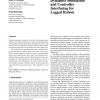Free Online Productivity Tools
i2Speak
i2Symbol
i2OCR
iTex2Img
iWeb2Print
iWeb2Shot
i2Type
iPdf2Split
iPdf2Merge
i2Bopomofo
i2Arabic
i2Style
i2Image
i2PDF
iLatex2Rtf
Sci2ools
IJRR
2000
2000
Dynamics Simulation and Controller Interfacing for Legged Robots
Dynamics simulation can play a critical role in the engineering of robotic control code, and there exist a variety of strategies both for building physical models and for interacting with these models. This paper presents an approach to dynamics simulation and controller interfacing for legged robots, and contrasts it to existing approaches. We describe dynamics algorithms and contact-resolution strategies for multibody articulated mobile robots based on the decoupled tree-structure approach, and present a novel scripting language that provides a unified framework for control-code interfacing, userinterface design, and data analysis. Special emphasis is placed on facilitating the rapid integration of control algorithms written in a standard object-oriented language (C++), the production of modular, distributed, reusable controllers, and the use of parameterized signal-transmission properties such as delay, sampling rate, and noise. KEY WORDS--simulation, walking, dynamics, control, in...
| Added | 18 Dec 2010 |
| Updated | 18 Dec 2010 |
| Type | Journal |
| Year | 2000 |
| Where | IJRR |
| Authors | Jesse A. Reichler, Fred Delcomyn |
Comments (0)

